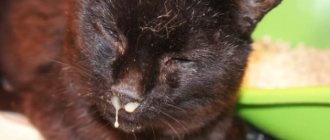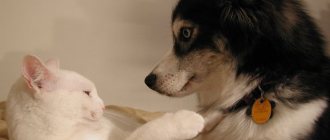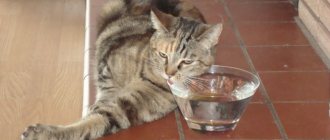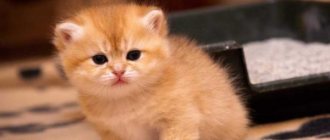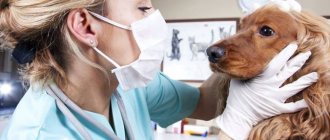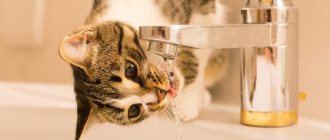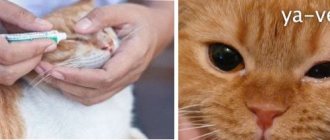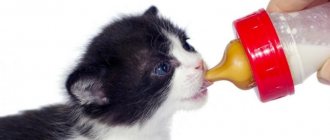13590Pavel
2
If you notice that your cat is squinting one eye, this may mean that the animal has a serious illness. Squinting of one eye is an alarming symptom indicating pain and discomfort in the pet's eye. Often, closing the eye is accompanied by profuse lacrimation or even suppuration. At this stage, it is important to immediately understand the causes of this condition in the cat and take all necessary therapeutic measures.
Causes
It should be noted right away: in most ophthalmological diseases of cats and humans, the pathogens are the same. Therefore, after touching your pet's eyes, you should wash your hands with special care.
Squinting indicates that the animal is experiencing pain or discomfort, which is caused by the following reasons:
- infectious diseases;
- injuries;
- inflammation of the third eyelid;
- glaucoma.
Clinical symptoms, diagnostic methods, treatment and prevention vary depending on the cause. Therefore, each disease is described in a separate section.
Causes of squinting eyes in cats
The cat's eye is an incredibly sensitive organ, so quite often it can be susceptible to inflammatory processes and the development of various pathologies. Many diseases can manifest themselves in this way when cats squint their eyes.
Let's take a closer look at the reasons for this phenomenon.:
- The presence of conjunctivitis is an inflammatory lesion of the mucous membrane of the eye. The disease is accompanied by swelling of the eyelids, mucous and purulent discharge. The affected eye becomes red and itchy, and a bluish or white cloudiness may also appear on it. To treat pathology, special eye drops are used, and rinsing procedures are also carried out. In later stages of the disease, antibiotic injections may be prescribed.
- Corneal erosion is damage to the cornea of the eye. An equally common reason why a cat squints one eye. The causes of the development of the disease are viral infections, injuries, burns, and glaucoma. Untimely treatment leads to the formation of a serious pathology - a corneal ulcer.
- Mechanical injuries to the cornea , which are always accompanied by severe pain and, as a result, the cat begins to squint its eyes. The insidiousness of such injuries lies in the penetration of pathogenic microorganisms into the depths of the tissues of the eye, where they further multiply. You should be especially careful about eye injuries caused by cat claws, since a large number of dangerous bacteria and worm eggs accumulate under them.
- An increase in eye pressure , which occurs due to age-related changes and the old age of the animal, is also a possible reason that the cat squints the visual organ. Due to the lack of proper treatment, this condition can predispose the cat to the development of one-sided blindness.
- Allergic reactions to flowers and plants , dust and household chemicals often cause a kitten to squint its eyes. A veterinarian will help identify the causative agent of the allergy and prescribe appropriate medications.
Contagious diseases
Damage to one eye is typical for the following infectious diseases:
- herpes;
- chlamydia;
- demodicosis;
Herpes
Blepharospasm
A viral disease better known as rhinotracheitis. An acute course is typical for unvaccinated kittens from two to three months. Chronic disease occurs in adult animals during periods of weakened immunity. At the initial stage, blepharitis develops, which is characterized by inflammation of the eyelids. They stick together and blepharospasm develops.
Subsequently, the second organ of vision is also affected. A characteristic sign of rhinotracheitis is ulcers on the cornea of the eye. Self-medication is dangerous because it can cause loss of one or both eyes, bronchopneumonia, constipation, and damage to internal organs. Treatment is prescribed by a veterinarian. To prevent rhinotracheitis, kittens and sexual partners are vaccinated before mating.
Chlamydia
The bacterial infection primarily affects kittens from 1 to 3 months. At this time, death is possible. With chlamydia, one eye first becomes inflamed, then the second is affected.
Be sure to read:
Seizures in a cat: physiological and pathological causes, symptoms, first aid, treatment
Chlamydia affects one eye first
Treatment is prescribed by a veterinarian. If ophthalmic ointments or drops are used, two eyes should be treated, even though one of them looks healthy. Prevention consists of proper feeding, satisfactory living conditions and vaccination with a polyvalent drug against chlamydia and other dangerous diseases of cats.
Demodicosis
Demodicosis glasses
The pathological process is caused by the activation of the subcutaneous mite due to a weakening of the immune defense. With asymmetrical lesions, demodectic glasses are formed around one of the eyes. Soreness causes the pet to squint one eye.
Treatment consists of treating the affected surface with external insecticidal and acaricidal agents. If the pathological process goes far, inflammation occurs.
As the affected area heals, it scars and squinting becomes a lifelong cosmetic defect. Prevention consists of proper feeding, as well as applying insecto-acaricidal drops Spot on to the healthy, intact skin of the withers, which protect the pet from fleas, helminths, cutaneous and subcutaneous ticks.
How to help your pet at home?
In order to provide qualified assistance to your cat, it is necessary, first of all, to know the root cause and accurate diagnosis of the disease. After all, the phenomenon in itself, when a cat squints its eye, is not considered an independent disease; it is only a consequence of hidden pathologies in the animal.
What to do if you can’t immediately visit the veterinarian’s office
- Examine your cat's eye for yourself as it squints. Make sure there are no foreign bodies in it.
- Gently but thoroughly rinse your pet's eyes with a slightly warm saline solution or regular boiled water. Use a sterile gauze swab.
- You need to collect discharge and pus very carefully, moving from the outer corner of the eye to the inner. Do not press on the eyeball under any circumstances, because the animal experiences severe pain and squints its eye to reduce it.
- It is strictly prohibited to use cotton pads during the rinsing procedure to avoid sticking of cotton fibers to the cornea of the diseased eye.
- It is strictly forbidden to use solutions of antiseptics and antibiotics for washing. This can aggravate the pet's condition and cause a burn to the cornea of the eye.
If your pet begins to systematically squint its eyes, you should immediately take the animal to the veterinarian’s office without waiting for complications!
Source
Injuries
Unilateral damage most often occurs in a fight, and also occurs when a cat is stung by a bee. One side swells and the eye closes. A pet injures its eye while chasing prey, or when a splinter gets into the soft tissue or a small solid particle gets into it. Ophthalmic drops are used for treatment.
If the use of an external remedy does not lead to the desired results. Seek veterinary help.
What to do
When it is noticed that the cat is squinting its eye, it should be carefully examined and washed thoroughly and carefully. Use sterile gauze, but not cotton pads or swabs, to prevent lint from getting into your eyes. Independent use of eye drops containing antimicrobial agents is unacceptable. They can cause harm to health or complicate diagnosis.
If rinsing does not help, seek veterinary help. You need to protect yourself. Touching with unwashed hands can cause infection and cause conjunctivitis. Children should not be allowed to process due to the risk of contracting chlamydia. Pregnant women should not take part in the treatment of pets, because infection with Toxoplasma cannot be ruled out.
If the cat constantly squints and washing the eyes does not help, the pet should be urgently taken to the clinic. The symptom indicates a disease that is dangerous for animals and humans.
Source
Inflammation of the third eyelid
The nictitating membrane in an active cat is invisible. The transparent membrane protects the eye sphere from dust particles and debris. Due to the inflammatory process, the membrane hypertrophies and no longer fits under the eyelids.
Most often, unilateral inflammation is observed due to the following reasons:
- infectious diseases;
- allergic reactions;
- injuries;
- internal non-communicable diseases;
- congenital predisposition.
Most often, Persians, Britons, as well as mixed breeds and cats of related breeds get sick. Treatment is surgery. To prevent inflammation of the eyelid, you should purchase a pet from trusted breeders and not engage in spontaneous selection.
Be sure to read:
Otitis in cats: symptoms and treatment, description, treatment with medications and folk remedies
Why does my pet squint his eyes?
Trauma and erosion
Mechanical damage to the visual organs provokes severe pain, as a result of which the pet closes one eye. In case of injury, an infection may enter the deep tissues of the eye, where pathogenic microorganisms subsequently multiply. If a pet is injured by cat claws, it is important for the owner to be as careful as possible and not delay a trip to the veterinary clinic. Such precautions are due to the fact that a huge amount of pathogenic microorganisms and helminth eggs accumulate under seals’ tights.
If a cat has one eye closed, damage to the cornea can also be suspected. The following factors can trigger the problem:
- infection of the visual organ;
- traumatic injuries;
- increased intraocular pressure;
- burns.
If proper and timely treatment is not carried out, the possibility of a corneal ulcer cannot be excluded. This pathology is extremely serious, sometimes leading to complete blindness or loss of the eyeball. In most situations, drug therapy does not help to cope with the problem, and the cat is prescribed surgical intervention.
Old age
Age-related changes in the animal’s visual apparatus can lead to similar symptoms.
Age-related changes in the body of pets often cause an increase in intraocular pressure. The kitten experiences pain in the affected visual organ, which forces it to close its eye, even if no light enters it, causing it to squint. Often the pathological process leads to inflammation of the mucous membrane of the eye, as a result of which one-sided blindness is not excluded.
Conjunctivitis
It is an inflammatory process that occurs in the mucous membrane of the visual organ. If a cat closes one eye, this mainly means the development of this particular disease. In addition to the fact that the cat squints, mucous or purulent discharge, swelling of the eyelids, and redness of the mucous membrane are also observed. The organ of vision itches and itches, so the cat constantly rubs it. Sometimes there is clouding of the cornea.
Inflammation of the third eyelid
This pathology often leads to the pet trying to cover up the diseased organ.
The nictitating membrane performs a protective function. In a healthy pet it is not visible, but due to certain circumstances the third eyelid becomes inflamed and becomes noticeable. Pathology can be caused by heredity or traumatic injuries. As the disease progresses, the cat's tear production increases. If appropriate therapy is not carried out, the secretion becomes purulent. The cat squints one eye, the eyelids stick together.
Allergy in a cat
Allergic reactions can be to anything. The culprits include medications, household chemicals, care products, indoor plants, flower pollen, and food. In addition to the fact that the cat squints its eyes, the development of an allergy can be suspected based on the following signs:
- rashes on the skin;
- hair loss and swelling of certain areas of the body;
- sneezing and coughing;
- discharge from the nose and visual organs;
- peeling of the pads of the limbs;
- gagging;
- dyspnea;
- increase in body temperature.
Glaucoma
Glaucoma
Elderly pets suffer from numerous chronic diseases, against the background of which eye pathologies develop. With glaucoma, intraocular pressure increases. The affected organ becomes sensitive to the slightest irritation. The cat develops photophobia: bright light causes the affected eye to squint.
Congenital glaucoma is observed in Persian, Siamese and British kittens. The development of the pathological process can be slowed down if the underlying disease is treated. Full recovery is impossible. Conservative treatment is aimed at relieving pain. If pathological signs increase, surgery is performed. Most often, the damaged organ is removed.
Glaucoma in a kitten
Prevention of congenital diseases involves excluding parents of sick kittens from breeding. Thoroughbred young animals should be purchased from trusted breeders who value their reputation.
Chronic diseases of older animals are prevented by compliance with housing and feeding standards, timely deworming and treatment against external parasites.
What to do if the cat closed one eye?
First aid
Therapy for the condition in which kittens or older cats squint their visual organ is based on stopping the factor that caused the problem. If the owner notices this unpleasant symptom in a pet, the first thing he needs to do is take the animal to a veterinary clinic. The doctor will conduct the required examinations that will reveal the root cause.
If there is no opportunity to quickly deliver the cat to the clinic, the owner will need to independently examine the visual organ that the pet is squinting. It is important to make sure that there are no foreign objects in it. Then you should carefully rinse the cat's eyes with boiled water at room temperature or saline solution. You need to moisten gauze in the liquid and carefully wipe the cat’s eyelids.
It is forbidden to use cotton swabs, since the cotton wool can stick to the fur and then get on the cornea, worsening the pet’s condition. In addition, you will need to stop using antiseptic solutions. These medications can cause a corneal burn. If the problem is accompanied by purulent discharge, it is important to clean the eyes as carefully as possible. A person will need to move from the outer corner to the inner one.
Drug therapy
After providing first aid to your pet, a visit to the veterinarian should still take place. After carrying out diagnostic measures, the veterinarian will be able to select the correct treatment regimen. For example, if a cat squints its eye due to the development of conjunctivitis, he is prescribed antibacterial medications. They can be prescribed either in the form of eye drops or in the form of ointments.
Feeling jealous
There are legends about cat jealousy. They very clearly show their indignation when a newborn appears in the family or a new pet (kitten or puppy). The cat considers himself a royal person and the master of your apartment, and believes that any major changes must be agreed upon with him. Small nasty things from the still cute and calm cat cannot be avoided. Do not rush to give it to other hands, let it get used to new circumstances. After all, the cat experienced enormous stress; a rival appeared on his territory, encroaching on his unlimited power. The cat is afraid of losing the love of its owner, be patient and understanding. And with new pets, it is better to demarcate the territory, at least until they become friends.
Cats are happy and sad. They are able to experience not only emotions, but also a feeling of love. Each of them has their own favorite toys, food and favorite places in the house. Take care of your pets, and they will thank their beloved owner with their warmth and tender affection.
Disappointment
Sometimes cats can become bored, resentful and upset. Gray emotions such as disappointment, sadness and despondency are clearly illustrated by “body language”:
- a faded, absent look;
- ears turned to the sides;
- hunched posture;
- reluctance to play and move actively;
- tail down.
An increase in such signs in combination with disturbances in natural functions, loss of appetite and elevated body temperature indicates a serious illness of the animal and requires the intervention of a veterinary specialist.
